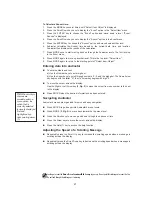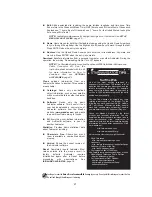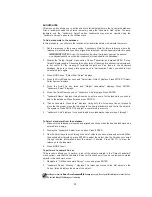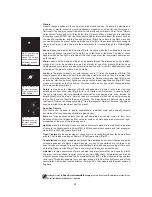
33
Looking at or near the
Sun
will cause
irreversible
damage to your eye. Do not point this telescope at or near the Sun.
Do not look through the telescope as it is moving.
CARING FOR YOUR TELESCOPE
Your StarNavigator telescope is a precision optical instrument designed to yield a lifetime of
rewarding observations. Given the care and respect due any precision instrument, your
telescope will rarely, if ever, require factory servicing. Maintenance guidelines include:
a.
Avoid cleaning the telescope’s optics: a little dust on the front surface of the telescope’s
correcting lens causes virtually no degradation of image quality and should not be
considered reason to clean the lens.
b.
When absolutely necessary, dust on the front lens should be removed with gentle strokes
of a camel hair brush or blown off with an ear syringe (available at any pharmacy). DO
NOT use a commercial photographic lens cleaner.
c.
Organic materials (
e.g., fingerprints) on the front lens may be removed with a solution of
3 parts distilled water to 1 part isopropyl alcohol. You may also add 1 drop of biodegradable
dishwashing soap per pint of solution. Use soft, white facial tissues and make short, gentle
strokes. Change tissues often.
CAUTION: Do not use scented or lotioned tissues or damage could result to the
optics.
d.
If used outdoors on a humid night, water condensation on the telescope surfaces will
probably result. While such condensation does not normally cause any damage to the
telescope, it is recommended that the entire telescope be wiped down with a dry cloth
before the telescope is packed away. Do not, however, wipe any of the optical surfaces.
Rather, simply allow the telescope to sit for some time in the warm indoor air, so that the
wet optical surfaces can dry unattended.
e.
If your telescope is not to be used for an extended period, perhaps for one month or more,
it is advisable to remove the batteries from the telescope. Batteries left in the telescope for
prolonged periods may leak, causing damage to the telescope’s electronic circuitry.
f.
Do not leave the telescope inside a sealed car on a warm summer day; excessive ambient
temperatures can damage the telescope’s internal lubrication and electronic circuitry.
Collimation
StarNavigator refracting telescopes are optically aligned (collimated) at the factory prior to
shipment, and it is never necessary to re-collimate the optics of these models. Meade
StarNavigator114 and StarNavigator130 reflecting telescope models are also factory-aligned,
but may occasionally require re-alignment, particularly if the telescope has received rough
handling in shipment. Before using one of these models for the first time, check the alignment
of the optics as outlined in this section. Good optical alignment is essential for telescope
performance, and in any case the alignment procedure is not difficult to follow.
The optical systems of Meade StarNavigator reflecting telescopes include the following parts:
primary mirror (1, Fig. 23); secondary mirror (2, Fig. 23); secondary mirror-holder (3, Fig. 23);
secondary mirror-vanes (4, Fig. 23) and (1, Fig. 24); primary mirror-tilt screws (5, Fig. 23). The
telescope’s image is brought to a focus at (6, Fig. 23).
1.
Confirm alignment - To confirm optical alignment look down the focuser drawtube (1, Fig.
26) with the eyepiece removed. The edge of the focuser drawtube frames reflections of the
primary mirror (2, Fig. 26), the secondary mirror (3, Fig. 26), the three (“spider”) vanes (4,
Fig. 26) holding the secondary mirror, and the observer’s eye (5, Fig. 26). With the optics
properly aligned, all of these reflections appear concentric (centred), as shown in Fig. 26.
Any deviation from concentricity of any of these telescope parts with the eye requires
adjustments to the secondary mirror-holder (Fig. 24) and/or the primary mirror cell (Fig.
25,) as described below.
2.
Secondary mirror-vane adjustments: If the secondary mirror (1, Fig. 27) is left or right of
centre within the drawtube (2, Fig. 27), slightly loosen the 3-vane adjustment/lock knobs (1, Fig.
24) located on the outside surface of the main tube and slide the entire secondary mirror-holder
system up or down in the slotted holes of the main tube until the secondary mirror is centred in
the drawtube. If the secondary mirror (1, Fig. 27) is above or below centre within the drawtube,
Summary of Contents for starnavigator ng series
Page 8: ...This page folds out...














































